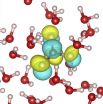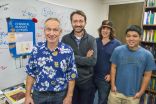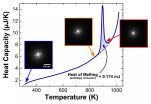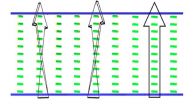(Press-News.org) Though it garners few public headlines, carbonic acid, the hydrated form of carbon dioxide, is critical to both the health of the atmosphere and the human body. However, because it exists for only a fraction of a second before changing into a mix of hydrogen and bicarbonate ions, carbonic acid has remained an enigma. A new study by Berkeley Lab researchers, has yielded valuable new information about carbonic acid with important implications for both geological and biological concerns.
Richard Saykally, a chemist with Berkeley Lab's Chemical Sciences Division and a professor of chemistry at the University of California (UC) Berkeley, led a study that produced the
first X-ray absorption spectroscopy (XAS) measurements for aqueous carbonic acid. These XAS measurements, which were obtained at Berkeley Lab's Advanced Light Source (ALS), were in strong agreement with supercomputer predictions obtained at the National Energy Research Scientific Computing Center (NERSC).
The combination of theoretical and experimental results provides new and detailed insights into the hydration properties of aqueous carbonic acid that should benefit the development of carbon sequestration and mitigation technologies, and improve our understanding of how carbonic acid regulates the pH of blood.
"Our results support an average hydration number of 3.17 with the acid's two protons each donating a strong hydrogen bond to solvating waters, the carbonyl oxygen accepting a strong hydrogen bond from solvating water, and the hydroxyl oxygen molecules accepting weak hydrogen bonds from the water," says Saykally. "XAS data must be interpreted by comparing measurements to results from a calculated spectrum, which is a serious challenge. The strong agreement between our calculated and observed X-ray spectra is a new and significant achievement."
The molecular dynamics simulations and first principles density functional theory method used to model and interpret the XAS measurements were carried out under the leadership of David Prendergast, a staff scientist in the Theory of Nanostructures Facility at Berkeley Lab's Molecular Foundry. The Molecular Foundry, NERSC and the ALS, are all DOE Office of Science national user facilities hosted at Berkeley Lab.
"Using our first-principles molecular dynamics model and molecular dynamic simulations, we were able to simulate how carbonic acid is solvated by water," Prendergast says. "We then converted this information into a predicted XAS absorption spectrum that could be directly compared with experimental measurements at the ALS."
Saykally and Prendergast have published their results in Chemical Physical Letters. The paper is titled "The hydration structure of aqueous carbonic acid from X-ray absorption spectroscopy." Saykally is the corresponding author. Other co-authors, in addition to Prendergast, are Royce Lam, Alice England, Alex Sheardy, Orion Shih, Jacob Smith and Anthony Rizzuto.
When carbon dioxide dissolves in water about one-percent of it forms carbonic acid, which almost immediately dissociates to bicarbonate anions and protons. Despite its fleeting existence – about 300 nanoseconds - carbonic acid is a crucial intermediate species in the equilibrium between carbon dioxide, water and many minerals. It plays a crucial role in the carbon cycle – the exchange of carbon dioxide between the atmosphere and the oceans – and in the buffering of blood and other bodily fluids. The short life span of carbonic acid in water has made it extremely difficult to study.
Saykally and his research group overcame this obstacle with their development of a unique liquid microjet mixing technology in which two aqueous samples rapidly mix and flow through a finely tipped nozzle that is made from fused silica and features an opening only a few micrometers in diameter. The resulting liquid beam travels a few centimeters in a vacuum chamber before it is intersected by an X-ray beam then collected and condensed out. Saykally and his group have set up their liquid microjet system at ALS Beamline 8.0.1, a high flux undulator beamline that produces X-ray beams optimized for XAS studies
"The key to our success was an advance in our liquid microjet technology that enables us to achieve a rapid mixing of our reactants, bicarbonate and hydrochloric acid, and immediate probing of the carbonic acid products," Saykally says.
For this study, he and his group used a variation of XAS called Near Edge X-ray Absorption Fine Structure (NEXAFS) spectroscopy, an atom-specific probe technique of both the electronic structure of a molecule and its local chemical environment. NEXAFS is ideal for obtaining detailed characterizations of hydration interactions, however, it has largely been limited to studies in gases and solids because of the difficulties of working with liquid samples in a high vacuum. By incorporating their microjet technology into the high-vacuum environment of a synchrotron X-ray beamline, Saykally and his group are able to perform NEXAFS on liquid samples.
The researchers behind this study say that their results are important for understanding and modeling how the chemical equilibrium between carbonic acid and carbon dioxide proceeds in saline aquifers and other proposed carbon sequestration media. The same equilibrium process governs respiration in living organisms.
"As carbonic acid in both the gas and solid phases has been fairly well studied, our new water solution work will facilitate the development of detailed models for the reversible gas-liquid chemistry of carbon dioxide," Saykally says.
INFORMATION:
This research was supported by the DOE Office of Science.
Lawrence Berkeley National Laboratory addresses the world's most urgent scientific challenges by advancing sustainable energy, protecting human health, creating new materials, and revealing the origin and fate of the universe. Founded in 1931, Berkeley Lab's scientific expertise has been recognized with 13 Nobel prizes. The University of California manages Berkeley Lab for the U.S. Department of Energy's Office of Science. For more, visit http://www.lbl.gov.
DOE's Office of Science is the single largest supporter of basic research in the physical sciences in the United States, and is working to address some of the most pressing challenges of our time. For more information, please visit the Office of Science website at science.energy.gov/.
When studying extremely fast reactions in ultrathin materials, two measurements are better than one. A new research tool invented by researchers at Lawrence Livermore National Laboratory (LLNL), Johns Hopkins University and the National Institute of Standards and Technology (NIST) captures information about both temperature and crystal structure during extremely fast reactions in thin-film materials.*
The combined device will help scientists study new materials and processes used to make advanced technologies, including state-of-the-art semiconductors and flat-screen ...
Abandoned penguin chicks that were hand-reared and returned to the wild showed a similar survival rate to their naturally-reared counterparts, according to a study published October 22, 2014 in the open-access journal PLOS ONE by Richard Sherley from University of Cape Town and colleagues.
The Endangered African penguin population has been rapidly decreasing since 2001. In the Western Cape of South Africa, penguins breed from February to September and moult between September and January, once chicks have fledged. If adult penguins begin the moulting process, a 21 day ...
Wild chimpanzees living in disturbed habitat may use innovative strategies, like foraging crops at night, to coexist with nearby human activities, according to a study published October 22, 2014 in the open-access journal PLOS ONE by Sabrina Krief from Muséum national d'histoire naturelle and colleagues.
People expanding land use for agriculture and other activities are increasingly encroaching on wild chimpanzee habitat. To understand how chimpanzees are adjusting, researchers used camera-traps to observe chimpanzee behavior during incursions out of the forest into ...
VIDEO:
This video shows treatment with OTS964 induced cytokinetic defect with inter-cellular bridges that eventually led to cell apoptosis. Cell pictures were taken every 10 min.
Click here for more information.
A new drug, known as OTS964, can eradicate aggressive human lung cancers transplanted into mice, according to a report in Science Translational Medicine. The drug, given as a pill or by injection, inhibits the action of a protein that is overproduced by several tumor types, ...
Males of great bustard consume small doses of poison with a dual purpose: to eliminate intern parasites and, especially, to look healthier and stronger before females, allowing them to achieve a greater reproductive success. A team of researchers from the Spanish National Research Council has now suggested for the first time that this function of self-medication could be a mechanism of sexual selection. The study results are published in the PLOS ONE journal.
Juan Carlos Alonso, who led the project, CSIC researcher at the Department of Evolutive Ecology of the Spanish ...
A new study conducted by University of North Carolina School of Medicine researchers provides the first known evidence of how a similar acoustic characteristic in the cry sounds of human infants and rat pups may be used to detect the harmful effects of prenatal cocaine exposure on nervous system development.
"These findings are important because studies of prenatal drug exposure in humans are always limited by not knowing if infant nervous system damage was due to the effects of a specific drug, such as cocaine, or the effects of other associated factors, such as maternal ...
Bright colours appear on a fruit fly's transparent wings against a dark background as a result of light refraction. Researchers from Lund University in Sweden have now demonstrated that females choose a mate based on the males' hidden wing colours.
"Our experiment shows that this newly-discovered trait is important in female choice in fruit flies, and is the first evidence that wing interference patterns have a biological signalling function between the sexes during sexual selection", said Jessica Abbott, a biologist at Lund University.
The extremely thin wings of the ...
Following the study of a hospital that logged more than 2.5 million patient monitoring alarms in just one month, researchers at UC San Francisco have, for the first time, comprehensively defined the detailed causes as well as potential solutions for the widespread issue of alarm fatigue in hospitals.
Their study is in the Oct. 22 issue of PLOS ONE and available online.
The issue of alarm fatigue has become so significant that The Joint Commission, a national organization that accredits hospitals, named it a National Patient Safety Goal. This goal requires hospitals ...
WASHINGTON, Oct. 22, 2014—At first glance, the static, greyscale display created by a group of researchers from the Hong Kong University of Science and Technology, China might not catch the eye of a thoughtful consumer in a market saturated with flashy, colorful electronics. But a closer look at the specs could change that: the ultra-thin LCD screen described today in a paper in The Optical Society's (OSA) journal Optics Letters is capable of holding three-dimensional images without a power source, making it a compact, energy-efficient way to display visual information.
Liquid ...
Tropical Depression Nine formed over the western Bay of Campeche, Gulf of Mexico and is forecast to make a quick landfall on Mexico's Yucatan Peninsula. NOAA's GOES-East Satellite captured the birth of the depression.
NOAA's GOES-East Satellite captured an image of the birth of Tropical Depression 9 on Oct. 22 at 1600 UTC (12 p.m. EDT) in the western Bay of Campeche. The clouds associated with the depression stretched over the Yucatan Peninsula and into the western Caribbean Sea.
On Oct. 22, a Tropical Storm Warning was in effect from Celestun to Frontera, Mexico. The ...







